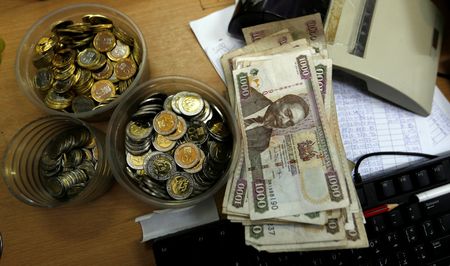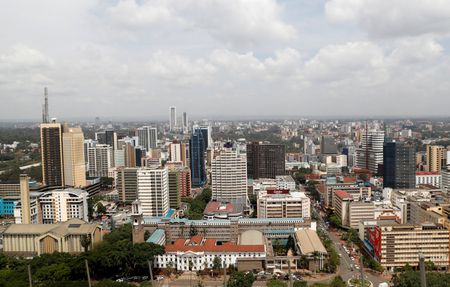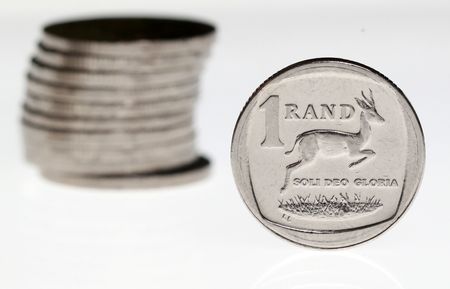By Samuel Indyk and Ankur Banerjee
LONDON (Reuters) -Global stocks drifted lower on Tuesday and the dollar dipped against major peers as concerns about tariffs and their impact on the economy lingered, while focus was turning to the Federal Reserve’s policy announcement on Wednesday.
Investor attention has been on the possibility of easing trade tensions between the U.S. and China after Beijing last week said it was evaluating an offer from Washington to hold talks over tariffs.
U.S. President Donald Trump said on Sunday that Washington is meeting with many countries, including China, and that his main priority with China is to secure a fair deal.
“We’ve seen a backpedalling and the trade risk has become lower,” said Lars Skovgaard, senior investment strategist at Danske Bank.
But with few details coming out about trade discussions, investors have been left trying to make sense of headlines coming out of the White House.
“Now we need to see some deals being announced otherwise the rise in stocks will fade again,” Skovgaard added.
Europe’s STOXX 600 is down 0.4% on Tuesday but remains close to its closing level on April 2, the day Trump announced his tariff proposals.
Britain’s FTSE 100 was up 0.1% and on track for a record 16th straight positive close, while Germany’s DAX was down 1%.
Investors were also processing a surprise from Germany where conservative leader Friedrich Merz failed to garner the parliamentary majority needed to become chancellor in an unexpected setback for his new coalition with the Social Democrats.
In Asia, MSCI’s broadest index of Asia-Pacific shares outside Japan, was flat with Japan closed for a holiday.
Chinese markets returned from an extended holiday with the blue-chip index and Hong Kong’s Hang Seng both up about 1%.
Attention was shifting to the Federal Reserve’s policy decision on Wednesday, where the central bank is widely expected to keep rates steady but the spotlight will be on how policymakers are likely to navigate a tariff-ridden path.
“The Fed remains caught between a rock and a hard place,” said Christian Scherrmann, DWS chief U.S. economist. “We think they will opt for a slightly more hawkish tone, but more in the direction of an extended pause than a potential hike.”
Traders are pricing in 75 basis points of easing this year with the first move possible in July, LSEG data showed.
DOLLAR SLIPS, RISES VS ASIAN FX
Trump’s erratic trade policies have fuelled significant waves of dollar selling since April as investors shifted away from U.S. assets, pushing the euro, yen and Swiss franc higher.
The euro on Tuesday was up 0.3% against the dollar at $1.1347, and the yen was up 0.5% at 142.95 per dollar.
That dollar selling has spread to other Asian FX, underscored by the Taiwan dollar’s record surge in recent sessions, which has stoked speculation that a revaluation of regional foreign exchange was possible to win U.S. trade concessions.
Its rally suggested a big unwinding was under way and shone a light on one economy, among many, where years of big trade surpluses have built up large long dollar positions at exporters and insurers that are now under question and on edge.
The Taiwan dollar was fairly sedate on Tuesday last fetching 30.28 per U.S. dollar, not far from the near three-year high of 29.59 it touched on Monday. [FRX/]
The focus turned to Hong Kong on Tuesday, where the de facto central bank bought $7.8 billion to stop the local currency from strengthening and breaking its peg to the greenback.
“The real action today is in Asian FX,” said Charu Chanana, chief investment strategist at Saxo in Singapore.
“If these currencies keep strengthening sharply, it could spark fears of a ‘reverse Asian currency crisis’, with potential ripple effects in the bond market amid fears that Asian institutions reassess their unhedged exposure to Treasury holdings.”
The Hong Kong Monetary Authority said on Tuesday it has been diversifying currency exposure in its investment portfolio to manage risks.
On the mainland, China’s yuan strengthened to its highest level since November at 7.2105 per dollar. [CNY/]
In commodities, oil rose after hitting four-year lows in the previous session that was driven by an OPEC+ decision to accelerate output increases. Brent crude futures were last up 2.2% at $61.55 per barrel. [O/R]
Gold prices rose 1.2% to a one-week high of $3,375/oz on safe-haven demand. [GOL/]
(Editing by Sam Holmes, Kate Mayberry and Sharon Singleton)









